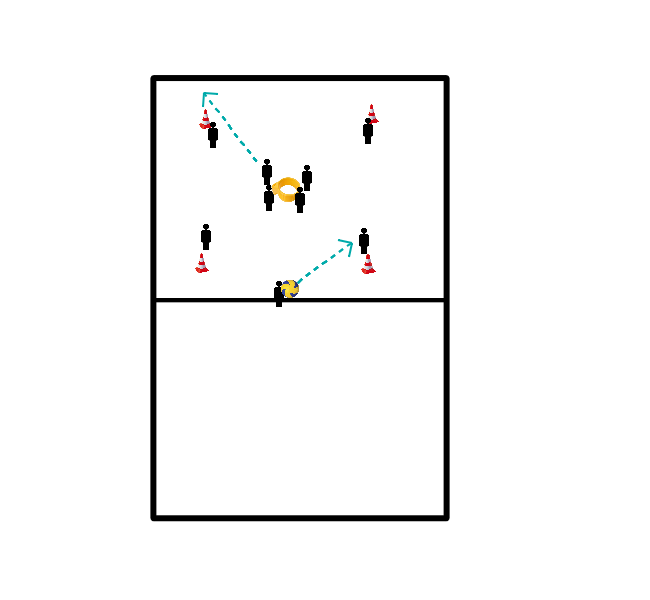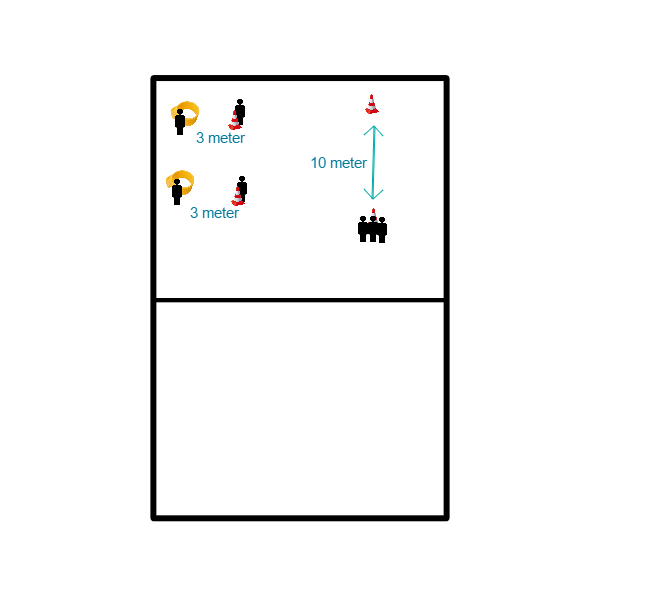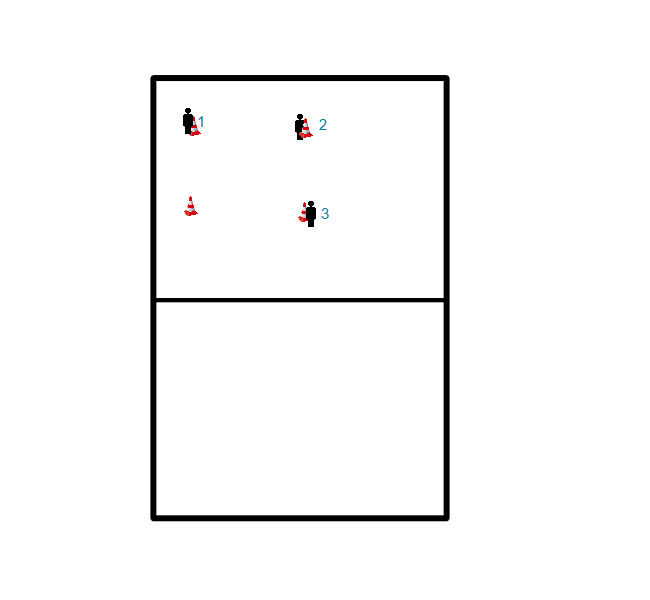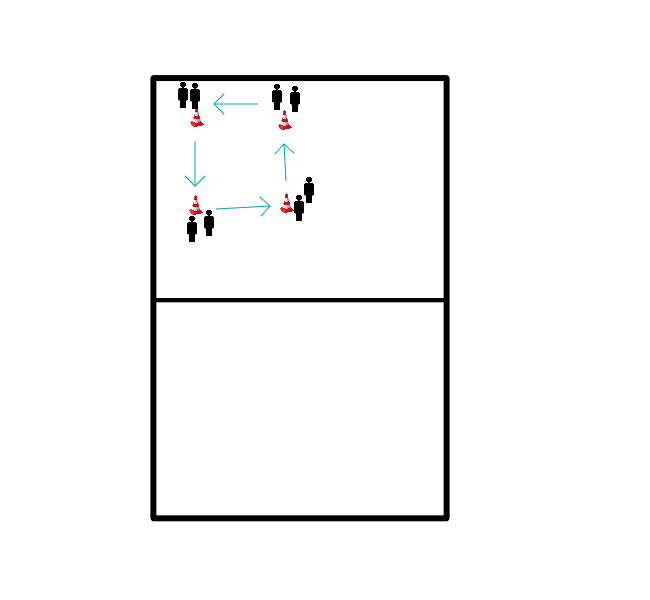Korfball drills
In short: exercise to determine 'the condition'. Organisation: Set out a course of a known length, for example 400 metres with a pylon every 50 metres.
In a period of 12 minutes the players have to try to cover the greatest possible
distance on foot. The distance covered is a measure
for 'the condition', better said: the endurance
for running. Kenneth Cooper used
the following table (for players over 30 years of age
shorter distances):
The Cooper test is very controversial. On the one hand because many korfball players
hate it (fear of getting tired?), on the other hand because the
test is not a good indicator of korfball fitness.
The power of jumping, the ability to recover after a long attack, the purity ofthe
shot from a long distance at the end of a game
are all things that are of great importance in a game and
are not measured by the test.
However,as an indication of someone's basic fitness at the beginning of the season,
the Coopertest can be used. However, the numbers
from the table aboveshould
beused with some flexibility
. Personally I think 2700 meters for ladies
is quite a long way, but 2800 meters for men is not very far at all
.
distances condition
very bad
less than 1500 less than 1600
Bad
1500 - 1800 1600 - 2000
Fair
1800 - 2200 2000 - 2400
good
2200 - 2700 2400 - 2800
very good
more than 2700 more than 2800
Inbrief: practising various running and jumping forms in a circle formation. Organisation: All the players hold each other by the hands and form a large circle. Then they let go of each other and take a number of steps backwards. The players are numbered in order: 1, 2, 1, 2, etc.
The number 1 runs in a fast pace around the number 2, going around the circle, so the first is passed on the left, the second on the right, the first on the left again, etc. After three laps, the number 2 follows. After three rounds the numbers 2 follow.
Same as in a., but now limping on the right leg. After one round change and go round on the left leg. Then the numbers 2 follow. Repeat one more time.
Jumping: the numbers 2 stand up, the numbers 1 jumps over them. After 2 rounds change.
Same as c., but the billy goats stand a bit higher. The pace needs to slow down a bit now, the important thing is to make a high jump with a powerful push off.
Exercise a. again, but now walk the other way.
The numbers 2 stand in a lying position, the numbers 1 jump over them with a long and high jump (a kind of running jump); the push-off takes place with one leg. After three rounds change. Then the same exercise again, but now take off with the other leg.
The numbers 2 lie down on their stomachs (or possibly squat). The number 1 jumps over them, while they take off with 2 legs. Between the numbers 2 they also jump (hopping). After two rounds change.
Inshort: practise various forms of walking, stopping, turning and jumping while running.
Organisation:lay out a 'course'onthe field (with pawns or baskets in a large circle). In the hall we just walk around. A whistle is very handy, especially on the field.
Walk around in a quiet pace, spreading the group out over the entire course. The space thus created must be maintained as much as possible during the entire exercise. At the sign of the trainer turn quickly and walk in the other direction.
The same, but now turn the other way. The first steps after the turn are done with a small sprint (short steps).
Walk backwards. At the sign of the trainer turn around again and walk backwards in the other direction. Alternately turn both ways.
Walk around with cross passes. Also the other way around.
Run around. At sign of the coach quickly sit (or lie down), stand up again, make a short sprint and continue running.
Tempo slightly higher than run. When the whistle is blown once, then a sprint is made. If the whistle is blown twice in quick succession, run backwards a few metres. Be careful, collisions can happen!
Run around. When the whistle blows, try to touch the person in front of you. After a maximum of 20 metres, continue sprinting at the same pace.
The players walk closer to each other, the distance between them is about 1,5 meter. At the sign of the trainer the last one in the row sprints to the front, zigzagging around the others. The trainer whistles every 2 or 3 seconds. Can you catch up with the person in front of you?
At the sign of the trainer the players make a high jump. Left and right turn in turn.
As i., but now the arms must also be raised when jumping up, like when catching a ball under the basket. Make sure you keep jumping high!
The players go round on their right leg, limping. After about half a minute, limping on the left leg.
Like k., but now the jumps must be made as big as possible. Try to get around in as little jumps as possible!
The players may alternate between limping on the left and on the right leg a few times. The players are numbered, alternately 1 and 2. The numbers 1 stand up. The numbers 2 jump over the numbers 1 until they are back on their own place. Then the other way around.
At the sign of the trainer, the players bend their knees and jump up high (push off with two legs, swinging their arms up as support).
Organisation: The players all line up on one side of the pitch.
Before starting these exercises, first perform a good warming-up (see above) with stretching exercises. The sequence was demonstrated by Margriet Poiesz (who is both an athletics and korfball coach) during one of the in-service training sessions of the North district of the NKTV
Steigerungen: running to the other side, whereby the pace is gradually increased to near-sprint speed
Skipping: a form of knee lifting at a very high tempo. The torso is in running position and is certainly not hanging back. The feet are reaching for the ground. This exercise focuses on the front swing phase.
Heels / buttocks or heel strike in high tempo (exercise for the back swing phase). The knees hang down, the trunk is in the walking position
Walk to the other side with long jumps (exercise for the back swing phase). Pay attention to a powerful, long push off. In this exercise, the feet also touch the ground, as it were.
simple running exercises for warming up, in which concentration and reaction also play an important role. Organisation: Pairs in an empty, marked out space.
Walk behind each other in a steady pace, criss-crossing the whole room. Number 2 follows every movement of number 1 as fast as possible, keeping about 1 metre distance. After a while change.
As a., but now the front runner tries to lose the back runner by sudden feints and/or tempo changes.
As a., but now other movements are also allowed: cross passes, jumping, lying down quickly and getting up again, etc.
Variations:
- Perform the same exercises with music
- Do the same exercises in groups of three or four. In this form, 'comical' situations will certainly occur now and then. It doesn't have much to do with korfball then.
- No more pairs: everyone walks freely through each other. The players walk towards each other, feint and then pass to the left.
- Like d., but now passing on the right
- Like d., but now they turn around each other and walk back.
- Special exercise for getting used to the hall: walk criss-cross through the whole hall, but not touching any line. Especially in halls with a lot of lines on the floor this is a good and fun exercise to get the 'contact with the hall' back in the legs.
- Like g., but now keep walking on the lines.
With 3 players at the basket, 1 attacker with the ball under the basket and 2 players who shoot the ball in motion (minimum distance 5 meters
). The attacker who is first to score 3 goals may remain in front of the basket and the attacker who has lost the game must take the place of the attacker.
1 pole, 1 ball, 4 hats in a square and 9 playersThe
4 attackers stand in a square (near the hats) around the basket, the 4 defenders hold the pole with one hand. The 9th person (the declarer) stands with the ball outside the square of the hats. The attacker passes the ball to one of the attackers, the defender who stands opposite the attacker who receives the ball must run around the hat and the attackers must now score as quickly as possible. If all goes well, the attackers quickly find the person who is free, as one of the defenders has to run around the hat-trick

You make a square, in it stands an attacker, the attacker must keep moving in the square while a defender walks by. One person always plays the ball. The defender looks at the ball and tries to catch it. Every time the attacker catches the ball, someone else runs into the box. When the defender catches the ball, he throws it back and you try again.
The whole group walks a circle around the yellow lines in the middle in a line. When the trainer calls 'yes', the person at the back of the line starts running as fast as possible. The children do this by pulling a sprint.
Options:
The children run after each other around the yellow lines in a line. The person at the front of the line can do whatever he wants for example: heels buttocks, sprints, lifts his knees etc. Whenthe trainer calls 'yes' the person at the back of the line starts to run as fast as possible and can choose what he wants to do. It must be something other than normal running/jogging, it may be sprinting.
Children will be divided among the poles, up to three children per pole.
Pole:
Two children stay by the pole. You have a declarator and a shooter, the shooter stands near the pawn at about 3 metres distance.
The shooter has to score 4 times and then there is a rotation.
Pawns:
There are two pawns facing each other at a distance of 10 meters. The other children stand near the pawn and run back and forth. When 4 times are scored by the shooter, there is a rotation.
Rotation:
The shooter becomes the runner.
The runner becomes a catcher.
The catcher becomes the shooter.
Variation:
The distance increases from the shooter.
The runner's distance increases.
Walk-throughs, short chance, penalty throw, etc. are taken.
 In short:
In short:
A trio has to pass the ball to each other in a square.That's tricky yes, because one is always missing....
Organisation:
Three players stand in an imaginary square about eight metres from each other. One corner remains unoccupied. The middle player (number 2) of the three has the ball.
You put four pawns in a square with a distance of 8 metres. Then you let the children make pairs. The children may take turns rolling the dice. You have three different rounds:
Round 1:
The children roll the dice. For example, if a group throws 4, each group must run 4 laps around the pawns.
Round 2:
The children first say who they are going to roll the dice for and then they get to roll passes. So they pick a group, say group 2 and roll the dice for that group.
Round 3:
The children first get to roll the dice and then they pick a group. This is almost always the most fun round. 








